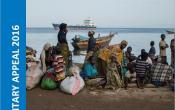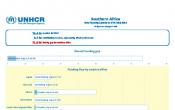Zambia
Operation: Zambia
Location
{"longitude":28,"latitude":-13,"zoom_level":0}
Latest update of camps and office locations 13 Jan 2016. By clicking on the icons on the map, additional information is displayed.
Key Figures
| 2015 end-year results | |
| 6,506 | refugee children were enrolled in primary school |
| 100% | of people of concern had access to primary health care and to HIV services |
| 1,749 | people with specific needs were provided with cash assistance |
| 923 | refugees were submitted for resettlement |
Latest Updates
People of Concern
4%
Increase in
2015
2015
| 2015 | 52,179 |
| 2014 | 50,216 |
| 2013 | 53,019 |

[["Refugees",26447],["Asylum-seekers",2411],["Others of concern",23321]]
Loading ...
Budgets and Expenditure for Zambia
< Back
2015
{"categories":[2012,2013,2014,2015,2016],"budget":[17.91054247,14.99645596,13.77666413,19.5134076,17.46076085],"expenditure":[8.62723189,8.00941753,9.46195797,8.98553227,null]}
{"categories":[2012,2013,2014,2015,2016],"p1":[17.91054247,14.99645596,13.77666413,19.5134076,17.46076085],"p2":[null,null,null,null,null],"p3":[null,null,null,null,null],"p4":[null,null,null,null,null]}
{"categories":[2012,2013,2014,2015,2016],"p1":[8.62723189,8.00941753,9.46195797,8.98553227,null],"p2":[null,null,null,null,null],"p3":[null,null,null,null,null],"p4":[null,null,null,null,null]}
Loading ...
CHOOSE A YEAR
- 2015
- 2016
Working environment
- The political situation in Zambia was stable throughout 2015. Nevertheless, with an unstable situation in Burundi and the eastern part of the Democratic Republic of the Congo (DRC), Zambia witnessed an increase in new asylum-seekers from both countries during the year.
- The country’s encampment policy continues to limit refugees’ freedom of movement and ability to locally integrate in urban areas.
- During the year, the Government of Zambia approved expanded criteria for the local integration of Angolans and criteria for Rwandans whose refugee status was recommended to cease in 2012 and 2013.
Population trends
- A 135 per cent increase in new arrivals (2,965), mainly from Burundi and the DRC, brought the total population of concern in Zambia to 52,179 people. More than 2000 asylum-seekers were granted refugee status and 639 asylum applications were rejected. A total of 444 people of concern (PoC) opted for voluntary repatriation, and another 710 refugees departed for resettlement.
Achievements and impact
- Self-reliance of PoC was advanced, with 5,213 tons of field crops and 2,000 tons of horticultural products harvested by refugees. UNHCR provided agriculture kits for 2,064 households. In addition, close to 40 youth were employed or started their own business, out of 71 who received entrepreneurship/business and life-skills training.
- 1,122 Angolan former refugees received resident permits.
- The first Training of Trainers for immigration officials on refugee protection and mixed migration was conducted.
- The dormant draft Refugee Bill from 2008 was revived and is being revised incorporating comments made by UNHCR.
- The Government and UNHCR together commissioned the first study on statelessness through the Ministry of Justice.
- Zambia successfully implemented pilot programmes on cash-based interventions and alternatives to detention, and started implementation of a graduation model pilot in one of the settlements.
Unmet needs
- Funding shortfalls affected the demarcation of an additional 1,213 plots, the construction of two markets and a bridge over the Mafwe River, as well as the further upgrading of clinics and schools needed to support local integration.
- The pursuit of self-reliance continued to be hampered by a lack of proper irrigation schemes and technical capacity, sufficient funding for specialized NGO partners, and poor linkage to markets. Further, a study on the impact of refugees on Zambia’s economy was not commissioned due to a lack of funds.
- Support for school feeding programmes, as well as bursaries for secondary and tertiary education, were inadequate to respond to identified needs.





